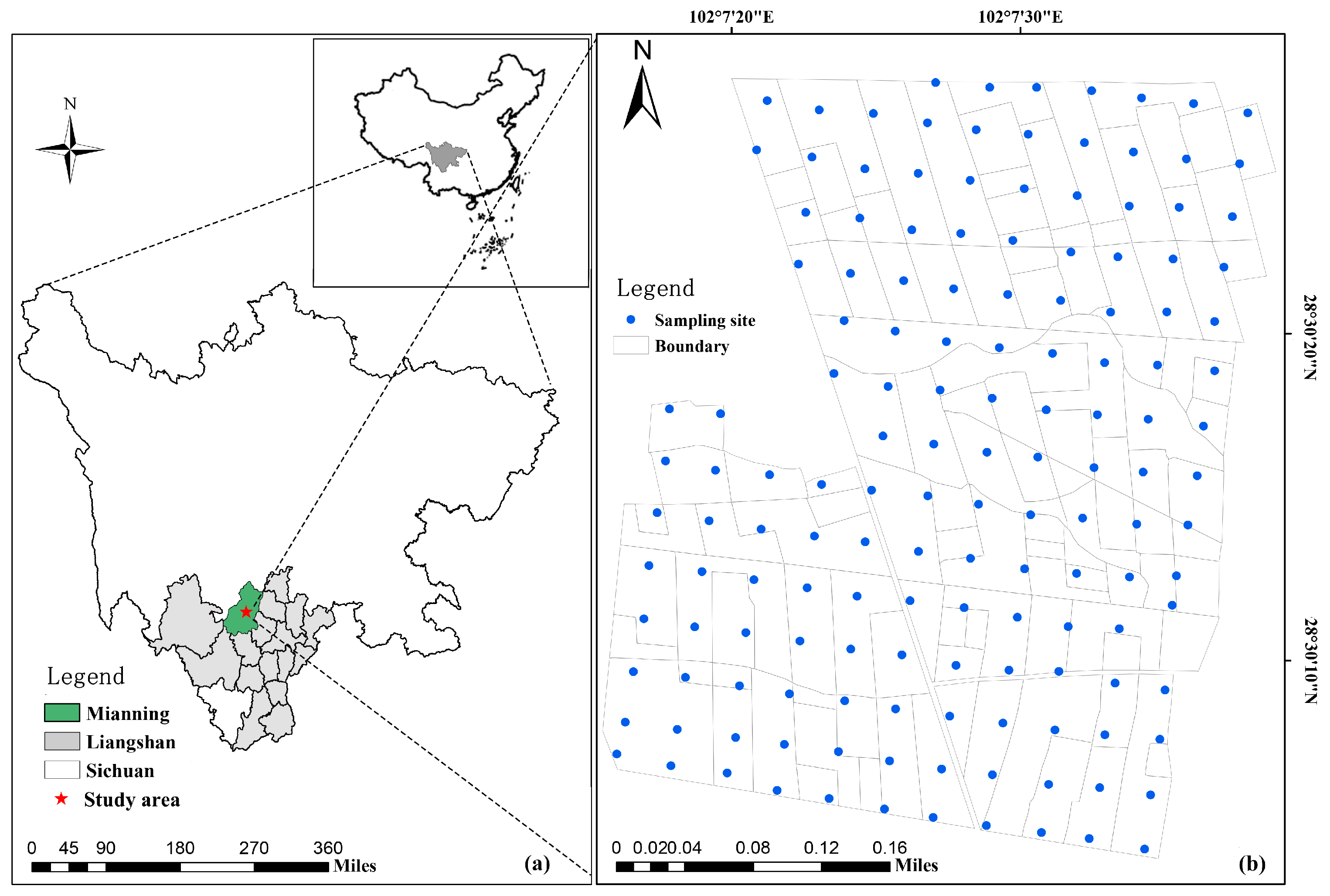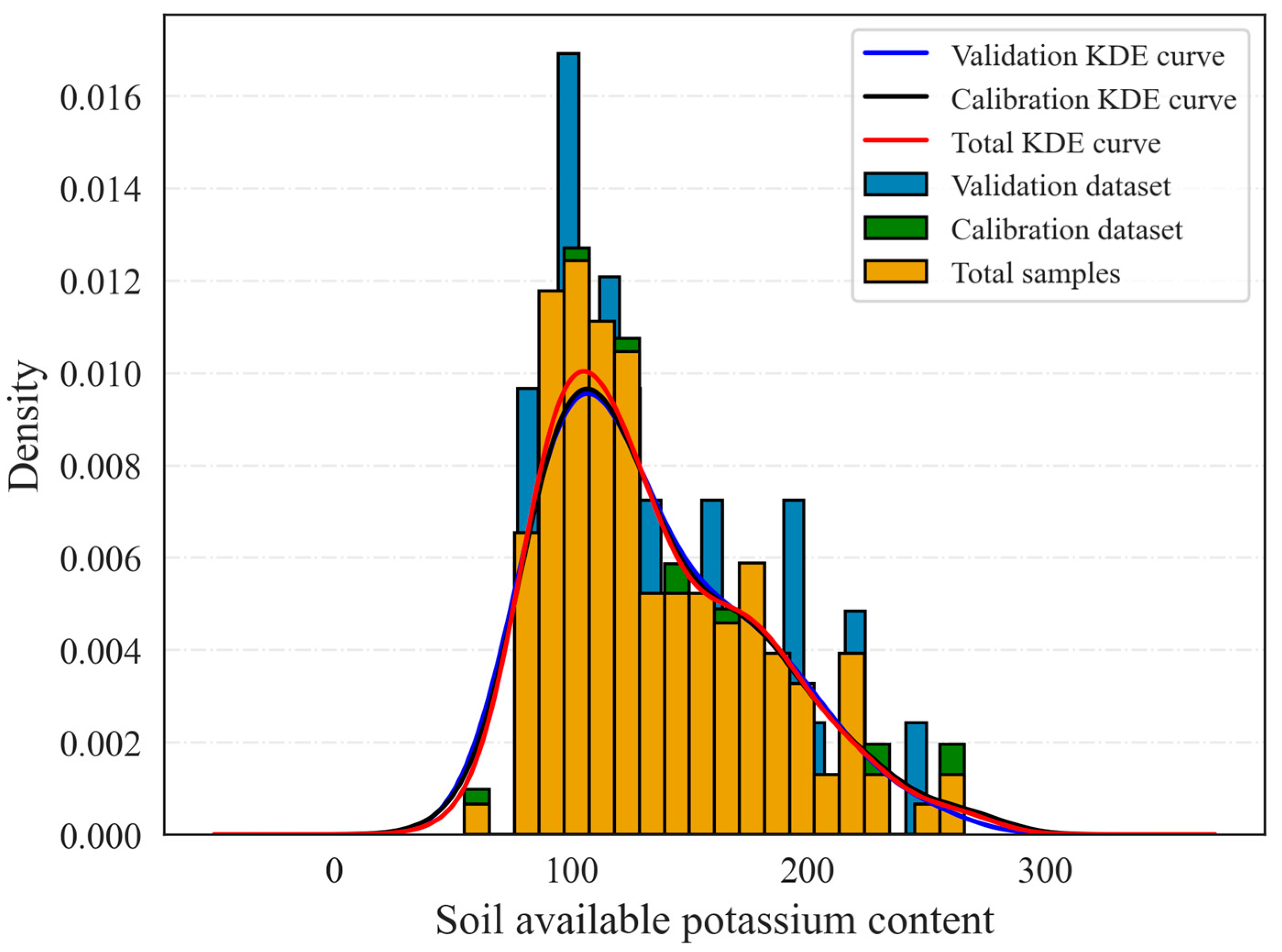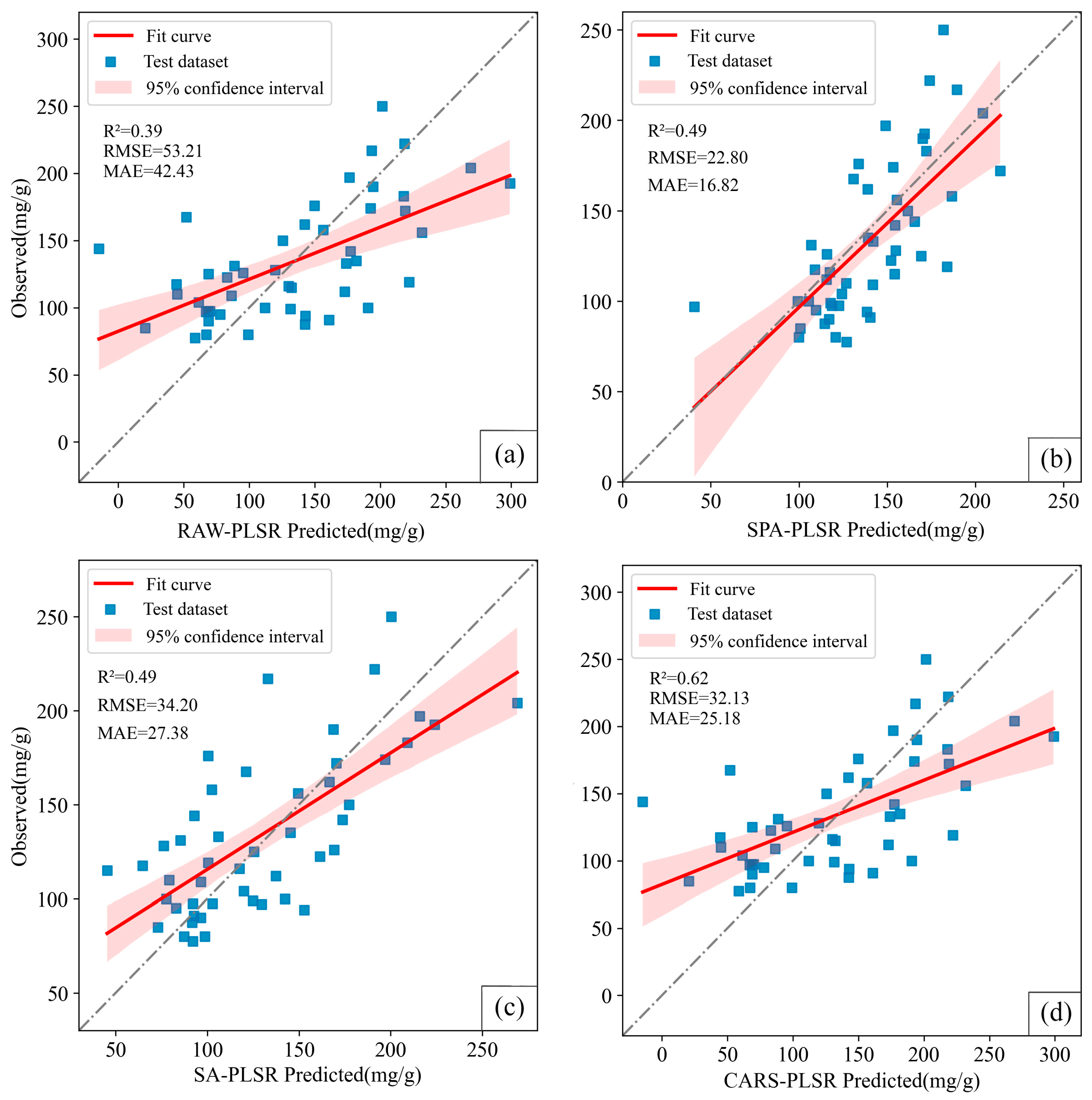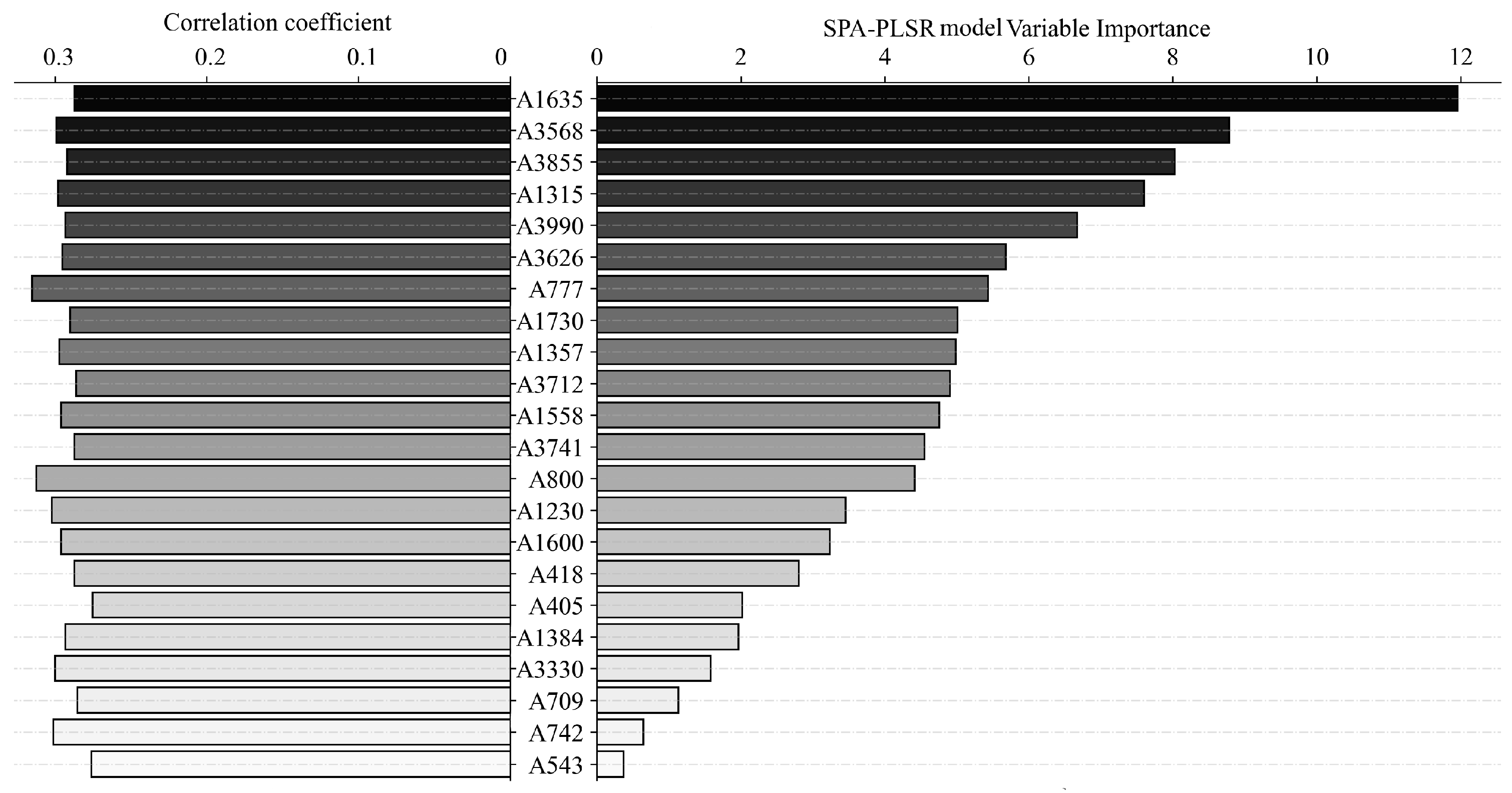Fourier-Transform Infrared Spectral Inversion of Soil Available Potassium Content Based on Different Dimensionality Reduction Algorithms
Abstract
:1. Introduction
2. Materials and Methods
2.1. Study Area
2.2. Soil Sample Collection and Chemical Analysis
2.3. FITR Spectral Information Acquisition
2.4. Dimension Reduction Algorithms
2.4.1. Successive Projections Algorithm (SPA)
2.4.2. Simulated Annealing Algorithm (SA)
2.4.3. Competitive Adaptive Reweighted Sampling (CARS)
2.5. Dataset Partitioning
2.6. Statistical Modeling and Accuracy Assessment
2.7. Contribution Analysis of Model Variables
3. Results
3.1. Description of Soil AK Content and FITR Characteristics
3.2. Dimensionality Reduction of Soil Spectral Data
3.3. The Results of Different Inversion Models
3.3.1. Model Performances of Different Dimensionality Reduction Methods
3.3.2. Contribution of Variables Using Different Inversion Models
4. Discussion
4.1. Comparison of Dimensionality Reduction Algorithms
4.2. Soil Available Potassium Characteristic Wavelengths
4.3. Limitation and Uncertainty
5. Conclusions
- (1)
- The application of the dimensionality reduction method can effectively limit the correlation between adjacent frequency bands, reduce data redundancy, and improve inversion modeling accuracy to a certain extent. Compared with the SA and CARS algorithms, the SPA was more suitable for spectral dimension reduction of soil AK content prediction.
- (2)
- The results show that the characteristic wavelengths were mainly around 777 nm, 1315 nm, 1375 nm, 1635 nm, 1730 nm and 3568–3990 nm.
- (3)
- Compared the performance of different soil AK inversion models, the SPA–PLSR model (R2 = 0.49, RMSE = 22.80, MAE = 16.82) was superior to the SA–PLSR and CARS–PLSR models, which has certain guiding significance for the rapid detection of soil AK content.
Author Contributions
Funding
Institutional Review Board Statement
Informed Consent Statement
Data Availability Statement
Conflicts of Interest
References
- Azzawi, W.A.; Gill, M.B.; Fatehi, F.; Zhou, M.; Acuña, T.; Shabala, L.; Yu, M.; Shabala, S. Effects of potassium availability on growth and development of barley cultivars. Agronomy 2021, 11, 2269. [Google Scholar] [CrossRef]
- Rawat, J.; Sanwal, P.; Saxena, J. Potassium and its role in sustainable agriculture. In Potassium Solubilizing Microorganisms for Sustainable Agriculture; Springer: New Delhi, India, 2016; p. 253. [Google Scholar]
- Römheld, V.; Kirkby, E.A. Research on potassium in agriculture: Needs and prospects. Plant Soil 2010, 335, 155–180. [Google Scholar] [CrossRef]
- Chen, Q.; Xin, Y.; Liu, Z. Long-term fertilization with potassium modifies soil biological quality in K-rich soils. Agronomy 2020, 10, 771. [Google Scholar] [CrossRef]
- Alomar, S.; Mireei, S.A.; Hemmat, A.; Masoumi, A.; Khademi, H. Comparison of Vis/SWNIR and NIR spectrometers combined with different multivariate techniques for estimating soil fertility parameters of calcareous topsoil in an arid climate. Biosyst. Eng. 2021, 201, 50–66. [Google Scholar] [CrossRef]
- Li, H.; Wang, J.; Zhang, J.; Liu, T.; Acquah, G.E.; Yuan, H. Combining Variable Selection and Multiple Linear Regression for Soil Organic Matter and Total Nitrogen Estimation by DRIFT-MIR Spectroscopy. Agronomy 2022, 12, 638. [Google Scholar] [CrossRef]
- Munawar, A.A. Rapid and simultaneous detection of hazardous heavy metals contamination in agricultural soil using infrared reflectance spectroscopy. In IOP Conference Series: Materials Science and Engineering; IOP Publishing: Bristol, UK, 2019; Volume 506, p. 012008. [Google Scholar]
- Cécillon, L.; Barthès, B.G.; Gomez, C.; Ertlen, D.; Genot, V.; Hedde, M.; Stevens, A.; Brun, J.J. Assessment and monitoring of soil quality using near-infrared reflectance spectroscopy (NIRS). Eur. J. Soil Sci. 2009, 60, 770–784. [Google Scholar] [CrossRef] [Green Version]
- Petit, T.; Puskar, L. FTIR spectroscopy of nanodiamonds: Methods and interpretation. Diam. Relat. Mater. 2018, 89, 52–66. [Google Scholar] [CrossRef]
- López-Lorente, Á.I.; Mizaikoff, B. Recent advances on the characterization of nanoparticles using infrared spectroscopy. TrAC Trends Anal. Chem. 2016, 84, 97–106. [Google Scholar] [CrossRef]
- Mudunkotuwa, I.A.; Al Minshid, A.; Grassian, V.H. ATR-FTIR spectroscopy as a tool to probe surface adsorption on nanoparticles at the liquid–solid interface in environmentally and biologically relevant media. Analyst 2014, 139, 870–881. [Google Scholar] [CrossRef]
- Tinti, A.; Tugnoli, V.; Bonora, S.; Francioso, O. Recent applications of vibrational mid-Infrared (IR) spectroscopy for studying soil components: A review. J. Cent. Eur. Agric. 2015, 16, 1–22. [Google Scholar] [CrossRef]
- Sørensen, L.K.; Dalsgaard, S. Determination of clay and other soil properties by near infrared spectroscopy. Soil Sci. Soc. Am. J. 2005, 69, 159–167. [Google Scholar] [CrossRef]
- Singh, P.; Singh, M.K.; Beg, Y.R.; Nishad, G.K. A review on spectroscopic methods for determination of nitrite and nitrate in environmental samples. Talanta 2019, 191, 364–381. [Google Scholar] [CrossRef] [PubMed]
- Xing, Z.; Du, C.; Shen, Y.; Ma, F.; Zhou, J. A method combining FTIR-ATR and Raman spectroscopy to determine soil organic matter: Improvement of prediction accuracy using competitive adaptive reweighted sampling (CARS). Comput. Electron. Agric. 2021, 191, 106549. [Google Scholar] [CrossRef]
- Jahn, B.R.; Linker, R.; Upadhyaya, S.K.; Shaviv, A.; Slaughter, D.C.; Shmulevich, I. Mid-infrared spectroscopic determination of soil nitrate content. Biosyst. Eng. 2006, 94, 505–515. [Google Scholar] [CrossRef]
- Stenberg, B.; Rossel, R.A.V.; Mouazen, A.M.; Wetterlind, J. Visible and near infrared spectroscopy in soil science. Adv. Agron. 2010, 107, 163–215. [Google Scholar]
- Guo, P.; Li, T.; Gao, H.; Chen, X.; Cui, Y.; Huang, Y. Evaluating calibration and spectral variable selection methods for predicting three soil nutrients using Vis-NIR spectroscopy. Remote Sens. 2021, 13, 4000. [Google Scholar] [CrossRef]
- Veum, K.S.; Sudduth, K.A.; Kremer, R.J.; Kitchen, N.R. Estimating a soil quality index with VNIR reflectance spectroscopy. Soil Sci. Soc. Am. J. 2015, 79, 637–649. [Google Scholar] [CrossRef]
- Xia, Y.; Ugarte, C.M.; Guan, K.; Pentrak, M.; Wander, M.M. Developing near-and mid-infrared spectroscopy analysis methods for rapid assessment of soil quality in Illinois. Soil Sci. Soc. Am. J. 2018, 82, 1415–1427. [Google Scholar] [CrossRef] [Green Version]
- Kinoshita, R.; Moebius-Clune, B.N.; van Es, H.M.; Hively, W.D.; Bilgilis, A.V. Strategies for soil quality assessment using visible and near-infrared reflectance spectroscopy in a Western Kenya chronosequence. Soil Sci. Soc. Am. J. 2012, 76, 1776–1788. [Google Scholar] [CrossRef] [Green Version]
- Margenot, A.J.; Calderón, F.J.; Parikh, S.J. Limitations and potential of spectral subtractions in Fourier-transform infrared spectroscopy of soil samples. Soil Sci. Soc. Am. J. 2016, 80, 10–26. [Google Scholar] [CrossRef] [Green Version]
- Angelopoulou, T.; Tziolas, N.; Balafoutis, A.; Zalidis, G.; Bochtis, D. Remote sensing techniques for soil organic carbon estimation: A review. Remote Sens. 2019, 11, 676. [Google Scholar] [CrossRef] [Green Version]
- Pullanagari, R.R.; Kereszturi, G.; Yule, I. Integrating airborne hyperspectral, topographic, and soil data for estimating pasture quality using recursive feature elimination with random forest regression. Remote Sens. 2018, 10, 1117. [Google Scholar] [CrossRef] [Green Version]
- Xu, L.; Schechter, I. Wavelength selection for simultaneous spectroscopic analysis. Experimental and theoretical study. Anal. Chem. 1996, 68, 2392–2400. [Google Scholar] [CrossRef]
- Schreier, H. Quantitative Predictions of Chemical Soil Conditions from Multispectral Airborne Ground and Laboratory Measurements. Pascal Fr. Bibliogr. Databases 1977, 106–112. [Google Scholar]
- Araújo, M.C.U.; Saldanha, T.C.B.; Galvao, R.K.H.; Yoneyama, T.; Chame, H.C.; Visani, V. The successive projections algorithm for variable selection in spectroscopic multicomponent analysis. Chemom. Intell. Lab. Syst. 2001, 57, 65–73. [Google Scholar] [CrossRef]
- Chong, I.G.; Jun, C.H. Performance of some variable selection methods when multicollinearity is present. Chemom. Intell. Lab. Syst. 2005, 78, 103–112. [Google Scholar] [CrossRef]
- Cai, W.; Li, Y.; Shao, X. A variable selection method based on uninformative variable elimination for multivariate calibration of near-infrared spectra. Chemom. Intell. Lab. Syst. 2008, 90, 188–194. [Google Scholar] [CrossRef]
- Meerts, W.L.; Schmitt, M.; Groenenboom, G.C. New applications of the genetic algorithm for the interpretation of high-resolution spectra. Can. J. Chem. 2004, 82, 804–819. [Google Scholar] [CrossRef] [Green Version]
- Jia, S.; Yang, X.; Zhang, J.; Li, G. Quantitative analysis of soil nitrogen, organic carbon, available phosphorous, and available potassium using near-infrared spectroscopy combined with variable selection. Soil Sci. 2014, 179, 211–219. [Google Scholar] [CrossRef]
- Peng, Y.; Zhao, L.; Hu, Y.; Wang, G.; Wang, L.; Liu, Z. Prediction of soil nutrient contents using visible and near-infrared reflectance spectroscopy. ISPRS Int. J. Geo-Inf. 2019, 8, 437. [Google Scholar] [CrossRef] [Green Version]
- Xu, D.; Zhao, R.; Li, S.; Chen, S.; Jiang, Q.; Zhou, L.; Shi, Z. Multi-sensor fusion for the determination of several soil properties in the Yangtze River Delta, China. Eur. J. Soil Sci. 2019, 70, 162–173. [Google Scholar] [CrossRef] [Green Version]
- Kyebogola, S.; Burras, L.C.; Miller, B.A.; Semalulu, O.; Yost, R.S.; Tenywa, M.M.; Lenssen, A.W.; Kyomuhendo, P.; Smith, C.; Luswata, C.K.; et al. Comparing Uganda’s indigenous soil classification system with World Reference Base and USDA Soil Taxonomy to predict soil productivity. Geoderma Reg. 2020, 22, e00296. [Google Scholar] [CrossRef]
- Bao, S.D. Soil and Agricultural Chemistry Snalysis; China Agricultural Press: Beijing, China, 1981. [Google Scholar]
- Zhang, H.L.; Wei, L.; Liu, X.M.; He, Y. SPA on spectral multivariable selection with different calibration methods for the determination of soil total nitrogen content. Int. Agric. Eng. J. 2017, 26, 9–15. [Google Scholar]
- Maraphum, K.; Ounkaew, A.; Kasemsiri, P.; Hiziroglu, S.; Posom, J. Wavelengths selection based on genetic algorithm (GA) and successive projections algorithms (SPA) combine with PLS regression for determination the soluble solids content in Nam-DokMai mangoes based on near infrared spectroscopy. Eng. Appl. Sci. Res. 2022, 49, 119–126. [Google Scholar]
- Luo, W.; Fan, G.; Tian, P.; Dong, W.; Zhang, H.; Zhan, B. Spectrum classification of citrus tissues infected by fungi and multispectral image identification of early rotten oranges. Spectrochim. Acta Part A Mol. Biomol. Spectrosc. 2022, 279, 121412. [Google Scholar] [CrossRef] [PubMed]
- Delahaye, D.; Chaimatanan, S.; Mongeau, M. Simulated annealing: From basics to applications. In Handbook of Metaheuristics; Springer: Cham, Switzerland, 2019; pp. 1–35. [Google Scholar]
- Kirkpatrick, S.; Gelatt, C.; Vecchi, M. Simulated annealing methods. J. Stat. Phys. 1984, 34, 975. [Google Scholar] [CrossRef]
- Hörchner, U.; Kalivas, J.H. Further investigation on a comparative study of simulated annealing and genetic algorithm for wavelength selection. Anal. Chim. Acta 1995, 311, 1–13. [Google Scholar] [CrossRef]
- Ballabio, C.; Panagos, P.; Lugato, E.; Huang, J.-H.; Orgiazzi, A.; Jones, A.; Fernández-Ugalde, O.; Borrelli, P.; Montanarella, L. Copper distribution in European topsoils: An assessment based on LUCAS soil survey. Sci. Total Environ. 2018, 636, 282–298. [Google Scholar] [CrossRef]
- Druet, S.A.J.; Taran, J.P.E. CARS spectroscopy. Prog. Quantum Electron. 1981, 7, 1–72. [Google Scholar] [CrossRef]
- Wang, C.; Li, X.; Wang, L.; Yang, C.; Chen, X.; Li, M.; Ma, S. Prediction of N, P, and K Contents in Sugarcane Leaves by VIS-NIR Spectroscopy and Modeling of NPK Interaction Effects. Trans. ASABE 2019, 62, 1427–1433. [Google Scholar] [CrossRef]
- Liu, J.; Dong, Z.; Xia, J.; Wang, H.; Meng, T.; Zhang, R.; Han, J.; Wang, N.; Xie, J. Estimation of soil organic matter content based on CARS algorithm coupled with random forest. Spectrochim. Acta Part A: Mol. Biomol. Spectrosc. 2021, 258, 119823. [Google Scholar] [CrossRef] [PubMed]
- Efron, B.; Tibshirani, R. Statistical data analysis in the computer age. Science 1991, 253, 390–395. [Google Scholar] [CrossRef] [PubMed] [Green Version]
- Xie, J.; Pan, Q.; Li, F.; Tang, Y.; Hou, S.; Xu, C. Simultaneous detection of trace adulterants in food based on multi-molecular infrared (MM-IR) spectroscopy. Talanta 2021, 222, 121325. [Google Scholar] [CrossRef]
- Peng, Z.; Guan, L.; Liao, Y.; Lian, S. Estimating total leaf chlorophyll content of gannan navel orange leaves using hyperspectral data based on partial least squares regression. IEEE Access 2019, 7, 155540–155551. [Google Scholar] [CrossRef]
- Teng, Y.; Wu, J.; Lu, S.; Wang, Y.; Jiao, X.; Song, L. Soil and soil environmental quality monitoring in China: A review. Environ. Int. 2014, 69, 177–199. [Google Scholar] [CrossRef]
- Linker, R.; Shmulevich, I.; Kenny, A.; Shaviv, A. Soil identification and chemometrics for direct determination of nitrate in soils using FTIR-ATR mid-infrared spectroscopy. Chemosphere 2005, 61, 652–658. [Google Scholar] [CrossRef]
- Shaviv, A.; Kenny, A.; Shmulevich, I.; Singher, L.; Reichlin, Y.; Katzir, A. IR fiberoptic systems for in situ and real time monitoring of nitrate in water and environmental systems. Environ. Sci. Technol. 2003, 37, 2807–2812. [Google Scholar] [CrossRef] [PubMed]
- Erny, G.L.; Brito, E.; Pereira, A.B.; Bento-Silva, A.; Patto, M.C.V.; Bronze, M.R. Projection to latent correlative structures, a dimension reduction strategy for spectral-based classification. RSC Adv. 2021, 11, 29124–29129. [Google Scholar] [CrossRef]
- Yun, Y.H.; Li, H.D.; Deng, B.C.; Cao, D.S. An overview of variable selection methods in multivariate analysis of near-infrared spectra. TrAC Trends Anal. Chem. 2019, 113, 102–115. [Google Scholar] [CrossRef]
- Vibhute, A.D.; Kale, K.V.; Mehrotra, S.C.; Dhumal, R.K.; Nagne, A.D. Determination of soil physicochemical attributes in farming sites through visible, near-infrared diffuse reflectance spectroscopy and PLSR modeling. Ecol. Process. 2018, 7, 26 . [Google Scholar] [CrossRef] [Green Version]
- Shi, T.; Chen, Y.; Liu, H.; Wang, J.; Wu, G. Soil organic carbon content estimation with laboratory-based visible-near-infrared reflectance spectroscopy: Feature selection. Appl. Spectrosc. 2014, 68, 831–837. [Google Scholar] [CrossRef]
- Yang, X. An extension to “Mid-infrared spectral interpretation of soils: Is it practical or accurate?”. Geoderma 2014, 226, 415–417. [Google Scholar] [CrossRef]
- Rutenbar, R.A. Simulated annealing algorithms: An overview. IEEE Circuits Devices Mag. 1989, 5, 19–26. [Google Scholar] [CrossRef]
- Tolles, W.M.; Nibler, J.W.; McDonald, J.R.; Harvey, A.B. A review of the theory and application of coherent anti-Stokes Raman spectroscopy (CARS). Appl. Spectrosc. 1977, 31, 253–271. [Google Scholar] [CrossRef]
- Zhang, D.; Xu, Y.; Huang, W.; Tian, X.; Xia, Y.; Xu, L.; Fan, S. Nondestructive measurement of soluble solids content in apple using near infrared hyperspectral imaging coupled with wavelength selection algorithm. Infrared Phys. Technol. 2019, 98, 297–304. [Google Scholar] [CrossRef]
- Wang, Z.; Wang, X.; Zhong, G.; Liu, J.; Sun, Y.; Zhang, C. Rapid determination of ammonia nitrogen concentration in biogas slurry based on NIR transmission spectroscopy with characteristic wavelength selection. Infrared Phys. Technol. 2022, 122, 104085. [Google Scholar] [CrossRef]
- Xiao, S.; He, Y.; Dong, T.; Nie, P. Spectral analysis and sensitive waveband determination based on nitrogen detection of different soil types using near infrared sensors. Sensors 2018, 18, 523. [Google Scholar] [CrossRef] [PubMed] [Green Version]
- Katuwal, S.; Knadel, M.; Moldrup, P.; Norgaard, T.; Greve, M.H.; de Jonge, L.W. Visible–Near-infrared spectroscopy can predict mass transport of dissolved chemicals through intact soil. Sci. Rep. 2018, 8, 11188. [Google Scholar] [CrossRef] [Green Version]
- Kawamura, K.; Tsujimoto, Y.; Nishigaki, T.; Andriamananjara, A.; Rabenarivo, M.; Asai, H.; Rakotoson, T.; Razafimbelo, T. Laboratory visible and near-infrared spectroscopy with genetic algorithm-based partial least squares regression for assessing the soil phosphorus content of upland and lowland rice fields in Madagascar. Remote Sens. 2019, 11, 506. [Google Scholar] [CrossRef] [Green Version]
- Dematte, J.A.M.; Garcia, G.J. Alteration of soil properties through a weathering sequence as evaluated by spectral reflectance. Soil Sci. Soc. Am. J. 1999, 63, 327–342. [Google Scholar] [CrossRef]
- Goetz, A.F.H.; Curtiss, B.; Shiley, D.A. Rapid gangue mineral concentration measurement over conveyors by NIR reflectance spectroscopy. Miner. Eng. 2009, 22, 490–499. [Google Scholar] [CrossRef]
- Demattê, J.A.M.; Ramirez-Lopez, L.; Marques, K.P.P.; Rodella, A.A. Chemometric soil analysis on the determination of specific bands for the detection of magnesium and potassium by spectroscopy. Geoderma 2017, 288, 8–22. [Google Scholar] [CrossRef]
- Barré, P.; Montagnier, C.; Chenu, C.; Abbadie, L.; Velde, B. Clay minerals as a soil potassium reservoir: Observation and quantification through X-ray diffraction. Plant Soil 2008, 302, 213–220. [Google Scholar] [CrossRef]
- Velde, B.; Peck, T. Clay mineral changes in the Morrow experimental plots, University of Illinois. Clays Clay Miner. 2002, 50, 364–370. [Google Scholar] [CrossRef]
- Cobo, J.G.; Dercon, G.; Yekeye, T.; Chapungu, L.; Kadzere, C.; Murwira, A.; Delve, R.; Cadisch, G. Integration of mid-infrared spectroscopy and geostatistics in the assessment of soil spatial variability at landscape level. Geoderma 2010, 158, 398–411. [Google Scholar] [CrossRef]






| Algorithm | Initialization of Variables | Evaluation Metric | Selection Strategy |
|---|---|---|---|
| SPA | all variables | maximum projection value on the orthogonal subspaces, RMSE | extreme value search, forward selection |
| SA | random sampling | Boltzman’s probability distribution, RMSECV | SA algorithm |
| CARS | Monte Carlo sampling | regression coefficient, RMSECV | exponentially decreasing function |
Disclaimer/Publisher’s Note: The statements, opinions and data contained in all publications are solely those of the individual author(s) and contributor(s) and not of MDPI and/or the editor(s). MDPI and/or the editor(s) disclaim responsibility for any injury to people or property resulting from any ideas, methods, instructions or products referred to in the content. |
© 2023 by the authors. Licensee MDPI, Basel, Switzerland. This article is an open access article distributed under the terms and conditions of the Creative Commons Attribution (CC BY) license (https://creativecommons.org/licenses/by/4.0/).
Share and Cite
Wang, W.; Zhang, Y.; Li, Z.; Liu, Q.; Feng, W.; Chen, Y.; Jiang, H.; Liang, H.; Chang, N. Fourier-Transform Infrared Spectral Inversion of Soil Available Potassium Content Based on Different Dimensionality Reduction Algorithms. Agronomy 2023, 13, 617. https://doi.org/10.3390/agronomy13030617
Wang W, Zhang Y, Li Z, Liu Q, Feng W, Chen Y, Jiang H, Liang H, Chang N. Fourier-Transform Infrared Spectral Inversion of Soil Available Potassium Content Based on Different Dimensionality Reduction Algorithms. Agronomy. 2023; 13(3):617. https://doi.org/10.3390/agronomy13030617
Chicago/Turabian StyleWang, Weiyan, Yungui Zhang, Zhihong Li, Qingli Liu, Wenqiang Feng, Yulan Chen, Hong Jiang, Hui Liang, and Naijie Chang. 2023. "Fourier-Transform Infrared Spectral Inversion of Soil Available Potassium Content Based on Different Dimensionality Reduction Algorithms" Agronomy 13, no. 3: 617. https://doi.org/10.3390/agronomy13030617
APA StyleWang, W., Zhang, Y., Li, Z., Liu, Q., Feng, W., Chen, Y., Jiang, H., Liang, H., & Chang, N. (2023). Fourier-Transform Infrared Spectral Inversion of Soil Available Potassium Content Based on Different Dimensionality Reduction Algorithms. Agronomy, 13(3), 617. https://doi.org/10.3390/agronomy13030617







